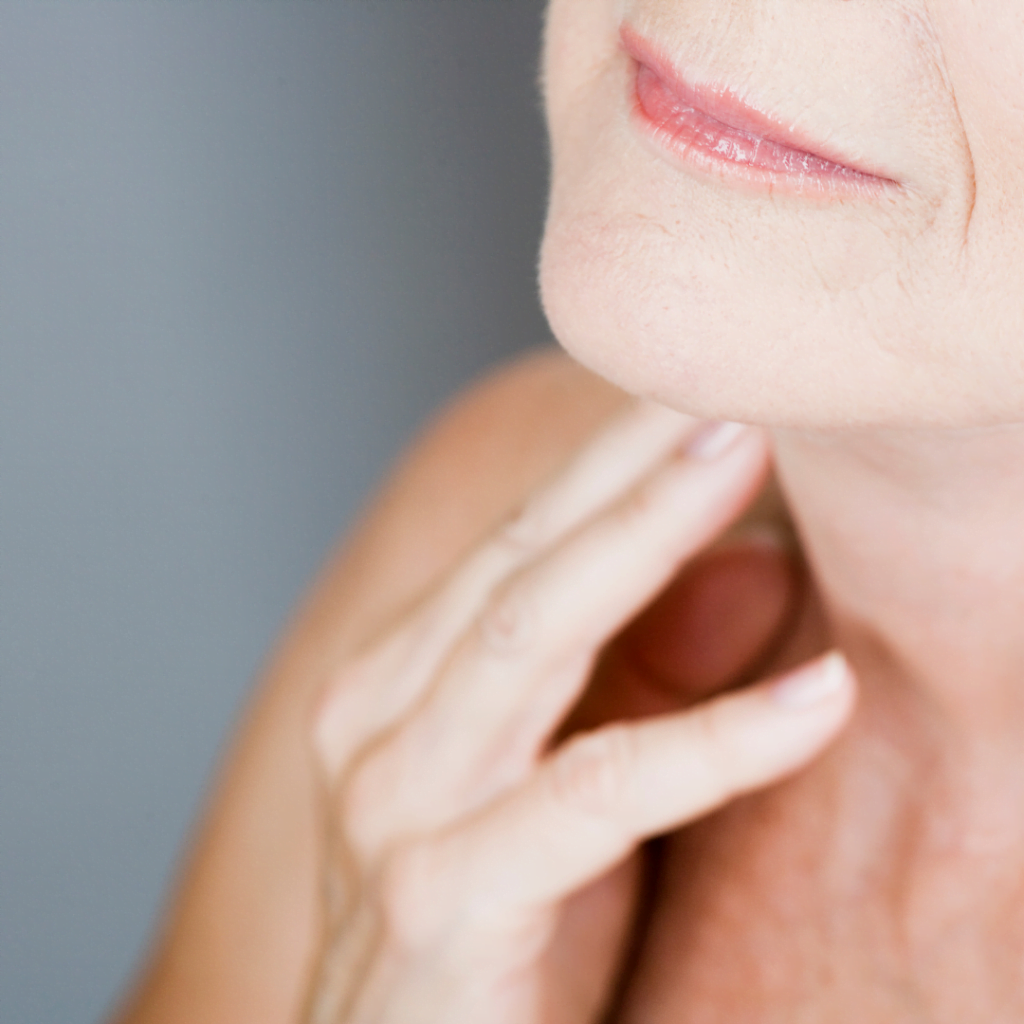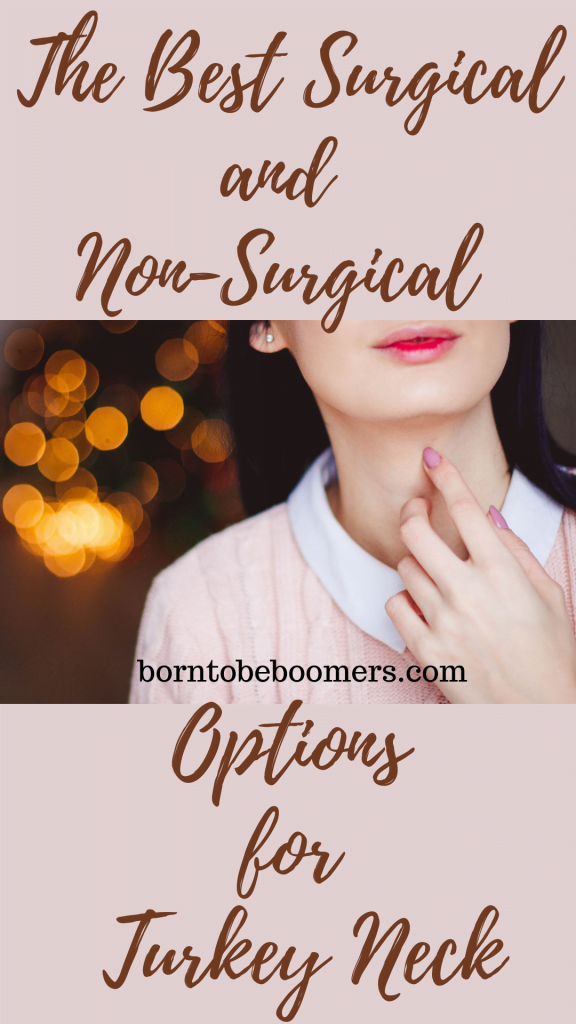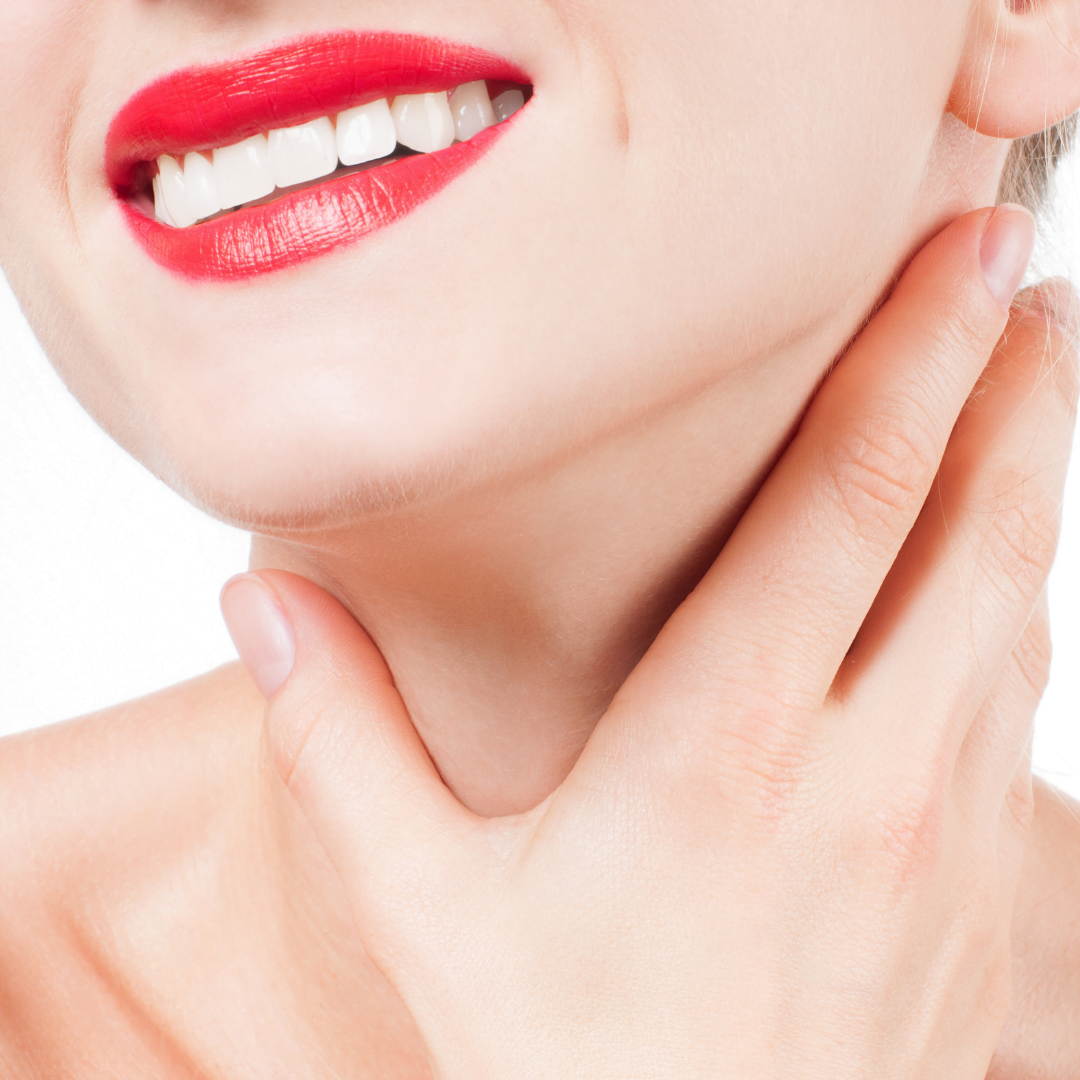There is always going to come a time when aging will take a toll on your skin, and you’ll have to deal with certain complications you never imagined you’d have—turkey neck is one of them.
One of the most common aging issues, the turkey neck, refers to loose, sagging, and wrinkly skin around your chin and neck area. “Turkey neck” is a slang term used to describe this condition, and it is inspired by the resemblance of those red wattles that hang down underneath a turkey’s neck.
Many people get confused between turkey neck and double chin (also known as submental fat). However, there is nothing to be confused about. In simple definitions, ‘double chin’ is caused by extra deposits of fat around the chin and results from weight gain. On the contrary, ‘turkey neck’ is caused by the weakening of your neck muscles and aging.
Table of Contents
I Started Noticing My Neck Issues Around 50
Turkey neck is a prevalent condition and starts occurring after the age of 40. No matter how beautiful your face or complexion, if you have a turkey neck developing, it’d give away your age and may even make you look older than you really are.
Nevertheless, this isn’t a serious condition and can be fixed or treated with a few simple neck and chin exercises. Certain treatments can also help you get rid of your turkey neck.
Below is the complete guide to turkey neck—what it is, what causes it, what exercises can help fix it, and what treatment options you have. Keep reading to figure out the changes you need to make in your skincare routine and the exercises you need to add to your daily schedule to treat turkey neck successfully.

What Is Turkey Neck
When you finally start worrying about the things that’ll show up with your increasing age, the first things that may cloud up your mind are fine lines, wrinkles, dull skin, rough skin texture, visible pores, etc.
However, these conditions occur on your face and are most often successor to the neck conditions. So, in reality, the décolleté (skin around your neck and chest) is the first place to show aging signs.
Décolleté is largely vulnerable to the signs of aging, and two of the most common conditions that affect this skin are crepey skin and turkey neck.
- Crepey skin usually shows up on the surface of your neck skin, making it look wrinkled, dry, and rough like the skin on your elbows.
- On the other hand, the turkey neck affects the intrinsic brawn and good skin elasticity of décolleté and ends up in loose, wrinkly, and saggy folds that look like a turkey’s wattle.
Note that while the wobbly wattle is a natural part of the turkey’s existence, yours is not, and you can fix it if you want to.
See: THE TRUTH ABOUT BREAD, BROMINES, IODINE DEFICIENCY, AND YOUR THYROID
What causes it?
In most cases, turkey neck results from aging and the factors that come along with that. Our skin naturally loses elasticity with age and time and has a rough time gaining fresh skin back, as stated in “the effects of aging on skin” by WebMD.
Along with that, several other factors pitch into the development of turkey neck over time, including:
Sun exposure
Décolleté, the skin on your neck and chest is usually thinner than the skin on your face. More than that, décolleté also contains fewer sebaceous glands, making it more prone to damage.
The primary job of sebaceous glands is to produce sebum, a group of complex oils that lubricate the skin to protect it against friction and moisture.
So if you take a moment to think about it, there is a high chance that you ignored putting sunscreen on the skin of your neck and chest, making it vulnerable to sun exposure. This results in sun damage, which breakdowns the collagen in your skin, resulting in losing your skin’s youthful elasticity.
Note that collagen is a protein present in your skin that provides support and structure to it.

Weakening of neck muscles
As you get older, fine lines, dark spots, and wrinkles start showing up on your skin, which is usually low collagen production.
According to an article published in Dermato Endocrinology, collagen production slows its pace at a rate of one percent per year of your age growth.
Moreover, as your collagen production cuts down naturally every year, the muscles that provide support and structure to your neck may also weaken. This results in the weakening of skin over your neck and eventually the formation of turkey neck or sagging neck skin.
The best way to prevent the formation of turkey neck is by avoiding lack of use and care of your facial muscles.
Excess neck fat
This is more common than you may think—there are so many people that naturally carry extra stubborn fat under their chin.
The extra fat deposits under their chin can cause the skin in that area to stretch and create folds that eventually start looking like a turkey’s wattle.
Genetics
Believe it or not, many things can come down genetically, good or bad, and you cannot do anything about it. In the same way, turkey neck can be hereditary but is most often due to aging, weight loss, or UV damage.
Anatomy
All of us have a small U-shaped bone in the neck (the hyoid bone) associated with our neck’s appearance.
So, when this bone is set further back towards the spine, the skin on your neck may seem sharply pulled back. But, on the contrary, if it is set further forward, the skin on your neck forms a round shape, which eventually worsens with age.
All of these factors are associated with the formation of the turkey neck. More factors include smoking and free radicals.
The good news is that most of these factors are controllable, and you can prevent a turkey neck from taking place by simply consuming a healthy diet, doing some neck exercises daily, and applying enough sunscreen for optimal results.
Now that you know what causes it, it is time we talk about how to fix this ugly-looking wattle and have clear good-looking skin on your chest and neck area.
See: CORTISOL: THE STRESS HORMONE AND WHAT YOU NEED TO KNOW FOR ADRENAL HEALTH
Surgical Procedures that treat Turkey Neck
If you’re done going about with a turkey neck, feeling unconfident, it is time you fix it. There are many medical procedures and non-surgical treatments that can offer you the best results for your problem.
However, surgeries are the most effective treatments for turkey neck, with impressively quick recovery time. Here are some of the most popular treatments that have shown visible results in recent years:
Botox (botulinum toxin type A)
By definition, the botox treatment isn’t a regular surgery but an injectable treatment that may help smooth your delicate skin to reduce the appearance of wrinkles and saggy folds and give it a good skin tone.
If you’re looking for a quick treatment that offers noticeable results without having you go through a long recovery time, Botox is for you.
However, you must understand that the results of this non-invasive treatment last only 3 to 4 months, and you’ll need to keep getting injections to maintain firm skin.
Neck Liposuction
If you look forward to longer-lasting results than what a botox treatment offers, you MUST consider cosmetic surgery. Neck liposuction can be your straightforward cosmetic procedure if you are worried about the excess fat in your neck area.
The neck liposuction surgery involves one or two tiny incisions made behind the ears or under the chin by a cosmetic surgeon to insert a small liposuction cannula that removes excess fat from your chin.
However, you may need an additional neck lift to get the desired good skin tone in some cases.

Mini Facelift and Neck Lift
An increasing number of people have started requesting neck lift surgery year over year, seeing that it offers incredible results. A mini facelift and neck lift can significantly improve the appearance of your neck’s skin so that it looks much more youthful.
During this surgery, the fat underneath your chin is removed, and the remaining tissue around the neck is tightened to create a more defining look around your chin. The surgery primarily focuses on lifting and repositioning the soft tissues around your neck to offer smoother, tighter contours.
Once the skin around your neck is at its correct place, it is secured by the help of sutures, and any excess fat or skin is cut away. The ideal candidates for neck lift surgery fall between the ages of 40 to 60 years old. However, the patients in their 70s see the best results of mini facelift surgery.
Mini facelift or neck lift is performed under general anesthesia, which is why most patients getting this surgery can go back home the same day. It usually takes around two hours from start to finish, but it can vary depending on how much skin on your neck needs to be altered.
MST Operation
If you’re looking for a minimally invasive technique to get rid of your turkey neck, then an MST operation is your best option.
This surgery involves the rejuvenation of your neck skin by tightening it using barbed threads. It is a tiny bit invasive and only leaves small scars, and the results give off a youthful appearance of your skin.
Z-Plasty
Widely known as anterior cervicoplasty, the Z-plasty surgery was introduced back in the 1970s. It is named after a vertical Z-shaped incision made along the neck for the surgery, which leaves a scar in a ‘Z’ pattern.
Patients with excess fat or skin or lax platysma muscle around their neck are good candidates for a Z-plasty surgery. This surgery involves a surgical incision underneath your chin to remove the excess fat and is bound using sutures. The benefits of the Z-plasty surgery include:
- Offers a better definition of the neck angle
- Reduces or eliminates the double chin
- Hides the incision
- Reduces the neck fullness, or the turkey wattle
- Reduces the tension on the scar, which leads to improved healing
The Z-plasty surgery may cause mild to moderate pain, along with some swelling and bruising. Therefore, you must ensure avoiding any strenuous activities for two weeks for better healing.
Along with that, do not absorb prolonged sun exposure and wear a compression garment for a few weeks.
See: OVER 50? LOSING MUSCLE MAY IMPACT YOUR QUALITY OF LIFE
Non-Surgical Alternatives to Treat Turkey Neck
Even though surgical neck lifts are the go-to treatment for removing excess skin under your chin, reducing bands or folds on the neck, and tightening loose skin, more and more people want to get treatment without going under the knife.
Non-surgical options aren’t as risk-friendly and dramatic as surgical treatments. Moreover, these treatments can significantly help in improving skin texture and tone. They eliminate the appearance of neck folds and wrinkles and giving an overall better youthful look.
The non-surgical approach to treating turkey neck offers many benefits, including:
- Fewer overall risks
- Comparatively less expensive
- Short procedure
- Quicker and better recovery time
The American Academy of Dermatology Association (AADA) suggests you go with radiofrequency, ultrasound, injectable dermal fillers, or laser resurfacing treatments before resorting to surgery. Here are some non-invasive treatment options that offer the benefits mentioned above:
Radiofrequency
Using radiofrequency to treat turkey neck is one of the most popular non-surgical treatments. In this treatment, a special device is used to heat the subcutaneous layer of the neck and chin to increase collagen production.
Even though this treatment is almost similar to Ultherapy, it offers to tighten right away. Many people notice neck skin to improve faster. However, you’ll likely have to wait six months to see full results and need more than one treatment for dramatic results.

Ultrasound therapy (Ultherapy)
In 2009, Ultherapy (an ultrasound technology) was approved by the Food and Drug Administration (FDA) to be used for noninvasive neck and chin lifts to treat neck aging.
This treatment involves an ultrasound machine to assert heat deep into your neck skin which helps your body produce more collagen. The improved collagen production then offers better support and structure to your skin, offering a good skin tone.
The ultrasound therapy shows visible results within 2 to 6 months with only a single time treatment.
Laser Treatments
Laser resurfacing is used to speed up cell regeneration by removing the exterior layer of skin cells on your neck and chin using a laser. When you get laser treatments, they are considered minimally invasive, and they require five to seven days of recovery time.
You may see results in only two weeks, which is quite good news.
Neck Exercises May Help
With increasing yoga and healthy exercises levels, there is an exercise for every muscle in your body. Doing a few sets of full-body exercises is the best way to stay healthy and keep your body fit, no matter how old you are.
The same goes for your neck muscles; flexing and exercising them regularly can help improve their strength and boost blood circulation.
Here are a few basic neck exercises that can help you strengthen your neck muscles and tone up your neck skin. Doing them as many times as feels physically safe can significantly help get rid of the turkey neck.
Chew
One of the simplest exercises you can do to contract your neck muscles is chewing. Though some people think of chewing as an exercise that involves your jaw muscles, it can also put some good work on your neck.
Step 1. Sit with your back straight, mouth and lips closed, and your face slightly tilted towards the ceiling.
Step 2. Now, bring your teeth apart and back together as if you’re chewing a huge burger, and make sure your lips keep closed.
Step 3. Continue doing this for 5 minutes, in 5 sets (30 seconds each).
Step 4. Make time to do this exercise at least three times a week to strengthen your neck muscles and diminish turkey neck.

Smooch
How much better can this get?
Firstly, no, that is not what you are doing. The smooch exercise is incredibly helpful in contracting the muscles close to your clavicle at the base of your neck.
Here are the steps to do this exercise:
Step 1. Sit up straight, and keep your eyes set on the ceiling fan.
Step 2. Now, push out your lips like you do when you kiss or the way a fish’s lips look. Ensure pushing them out a bit extra so that your neck muscles get involved.
Step 3. Repeat slowly, sending air smooches to your ceiling fan 15- 30 times.
Step 4. Do this exercise three to five times every week to get rid of your turkey neck.
Forehead barrier
This exercise may be a little complicated to assert a mind-muscle connection to. Still, it can be very helpful for strengthening your neck musculature only if you maintain the right pose.
Step 1. Sit straight on your chair, and place your hands on your forehead, assuming they are a barrier that you must push against. You can also use a wall instead of hands if you have good control over your posture.
Step 2. Now push your head against your hands while also not allowing your head to move forward.
The resistance of your hands against the movement will trigger the upper neck muscles and contract them. Hold this position for as long as it takes to start feeling your neck muscles burn.
Step 3. Release.
Step 4. Now turn around the exercise to interact with the muscles in your neck’s back. Place your hands behind your head, again assuming they are a barrier, and push your head against the barrier.
This resistance now will work on the muscles in the back of your neck and tighten them.
Step 5. Repeat this exercise at least two times a day for better results.
Bottom Line
As a part of other changes that happen to our body and skin, turkey neck is also completely naturaOurour skin naturally begins losing its tone and elasticity as we keep aging, resulting in saggy skin.
However, there are millions of simple things that you can do to maintain your skin’s health, keep it from aging, and live more years in your youthful appearance.
The best thing you can do is love your skin and take care of it by consuming healthy foods, preventing it from extreme sun exposure, and exercising regularly. In addition to that, a daily skincare routine can be your best way to prevent the aging process.
So ensure taking care of yourself; the healthier you are, the more it will reflect on your body, face, and skin.

These statements have not been evaluated by the Food and Drug Administration. Any product(s) on this website is not intended to diagnose, treat, cure, or prevent any disease.
Always consult a licensed health care professional before starting any supplement or nutraceutical. Especially if you are pregnant or have any pre-existing medical conditions. Individual results may vary. These are from my own experience and the experience of others and only our opinions.




